I don’t do beer tastings, mostly because my tasting group dissolved, but also I sort of outgrew the desire to drink the craziest, hardest to get whales ever. It really is just beer. It was fun while it lasted, I just don’t have the time or energy (or money) to keep it up. Good for all of those that can, I’m just over it. All that being said, this is a post about a beer tasting I set up, so I got off that high horse long enough to get dangerously drunk at a tasting one-more-time (this isn’t going to be the last time). One I’ve wanted to set up for a long time….Trappist beers.
In my last pedantry post about lambic, I said that I had no problem with people using the word “lambic” to describe beer made outside of the Senne valley…so this post might seem like I’m taking a different stance than the previous one by saying only Trappist monestaries should be able to use the “Trappist” on their beers, but I feel they are completely separate issues.
So….Trappist beer. In the opinion of many, the beers brewed in the handful of Trappist monasteries are some of the best beers in the world. My thought is that this prevailing opinion is the product of the brewing tradition, the history and mystique surrounding these few breweries, the relative scarcity of some of these beers outside of Europe (Belgium), and the simple fact that (most of) these beers are above average to amazing. I love these beers but it irks me when someone gives me a beer from a Belgian brewery and says, “It’s a Trappist!” I know this is going to be some high level beer geek pedantry, but I wanted to put down my thoughts in one place about what it means (really means) to be Trappist, what are the possible exceptions to the rules, and to drink some awesome beers.
First thing is first, when you say, “It’s a Trappist”…know what you are talking about. Not all beer from Belgium is Trappist (seems stupid to have to say that but I’ve had some annoying conversations). Having the word “Abbey” in the name doesn’t make it Trappist, again not as obvious as it should be. Even beer brewed at a monastery might not be Trappist….Additional misconceptions I’ve come across, not all Trappist beer is made in Belgium. There are Trappist breweries in Austria, the Netherlands, United States, Belgium, and formerly Germany, Bosnia, Algeria, and France. In order to be labeled “Authentic Trappist Product”, the beer in question must meet 3 criteria:
- The beer must be brewed at a Trappist monastery (within the property of monastery) by monks or under their direct supervision.
- The brewery, production and maintenance, is 100% the responsibility and under the control of the monestary.
- The revenue generated from the sale of the beer must be used to benefit the community and the mission of the monastery, not for profit.
While the tradition of monks brewing inside monasteries literally goes back more than 1300 years at this point, at the time of this post, there are 10 (TEN!!! maybe 11!!!) Trappist breweries. Just a few years ago there were a solid 7. Perhaps capitalizing on the popularity of Trappist beer, or maybe they were planning this entire time, 3 (or 4?) more have opened in the past several years. For the beer evaluation portion of this post, I will go in the order they started making beer (oldest to newest). This post is part rant, part history, and part (mostly) a beer tasting with a friend and fellow Trappist enthusiast, Ryan. We are going to drink an illogical amount of beer today. We aren’t going to drink EVERY available Trappist beer in the world, but we will drink at least one from each of the breweries and several beers from a few (proper glassware? You bet!!!). Here…we….go….(spoiler alert, we drank 19)
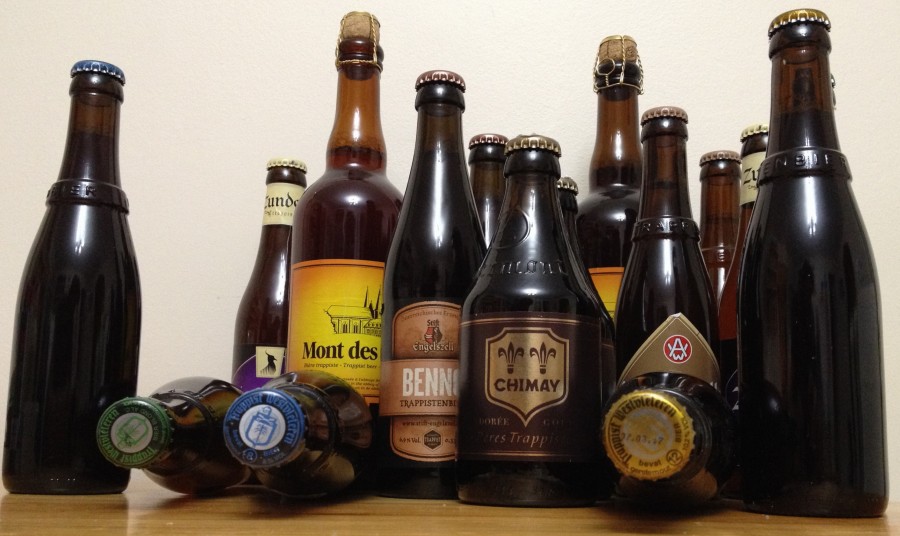
Brasserie de Rochefort
Rochefort opened its doors in 1595 making it the oldest of the Trappist breweries to date. They have been in continuous operation as a trappist brewery for more than 400 years. They have changed a lot over the past 400 years as one might suspect. Around the time Chimay started producing large quantities of beers, Rochefort requested that they don’t sell beer in the area of Rochefort because they were going out of business. Chimay declined and instead trained the monks to make better beer. After the war, their proudction increased drastically and they are one of the largest producers at this point. They make three beers at this time, Rochefort 6, 8, and 10. We drank the 6 and the 10.
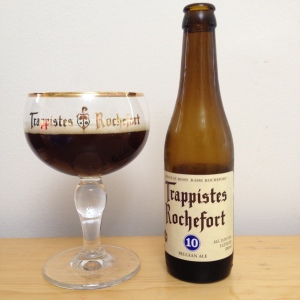
This was pretty early in the tasting and tasted side-by-side with Westvleteren 12. Both Westy 12 and this beer have strong sweetness and a nice malt body to them. Similar in color, dark brown and hazy, thin brown head, moderate retention, moderate lacing, medium carbonation. Aroma is dark fruit and anise. The anise in this beer is what sets it apart for me from the other strong darks, quads and dubbles we had today. Nice beer great finish.

Basically the last beer we had of the night, this is best described as 10 lite…it is pretty similar but less boozy, less sweet, and lighter in body. The color is slightly lighter as well…a really nice beer overall.
Brouwerij der Trappisten van Westmalle
Westmalle has been in continuous operation as a brewery since 1836. They have basically two beers they market commercially and supposedly the recipes for those two beers are pushing 100 years old at this point. They make a third beer called “Extra” so I went out of my way to grab that beer for our examination…what did we think?
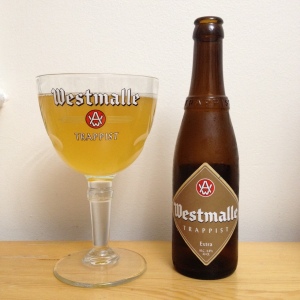
Westmalle Extra was served close to Chimay Dorée (see below) and my thoughts about both of them were “citrus”…this one more than the Chimay. This was a super light, airy, lemon citrus, almost witbier in character. Very nice, refreshing crisp.
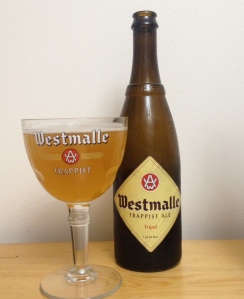
The tripel was much bigger than the Extra…this was heavily carbonated, strong yeast presence, nice aromatic malts, a dry finish, effervescent on the palate. A solid tripel for sure.

Westmalle Dubbel was beer #19 of the night…so it suffers from my fatigue. Nevertheless this is a good beer. Obviously darker than the other two, this beer is biggest in body and quite sweet. Nice yeast and malt character shining through, strong and sweet without being cloying or overpowering. Nice beer..really nice.
Brouwerij Westvleteren
Westvleteren opened the brewery for the first time in 1838. For a long time, Westvleteren 12 (Westy 12) was considered the “Best beer in the world” by the beer geek community. This is no longer the case, but Westy 12 is a solid quadruple. I still think it is one of the best beers in the world, for what it is worth. The problem with those titles is that an IPA is competing with a Quad or a saison or a lager…rubbish, complete rubbish. This is clearly one of the best beers in the world. This brewery is a victim of its own success. It was too good and too scarce to go unnoticed. Westvleteren makes three beers (now). They make the 12, 8, and “blonde”. Again, the number refer to the original gravity. They do no marketing and other than one obvious exception have never distributed their beer. It is available at a few shops in Belgium, one diner across the street from the monastery and the monastery itself.
Are their beers still good? I haven’t had a Westy in a few years and today I had all three…they are amazing. My favorite of the three we sampled was and always will be Westy 8. The 12 is good and gets a lot of attention but Westy 8 is superior and the best dubbel you will ever find. If you can only drink one beer from this place, it is the 8 without a doubt, but go out of your way to get these beers. They are all amazing.
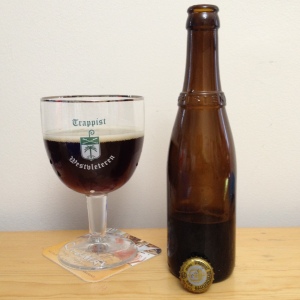
It is blasphemy to say so and a blind side-by-side may be in order, but this is not my favorite beer from Westvleteren and not my favorite quad. It is solid, a top 3 for me for sure. Aroma is sweet and molasses, brown sugar. Beer is medium to light in body, sweet on the palate with a nice round finish. This is a younger bottle and this beer ages amazingly.
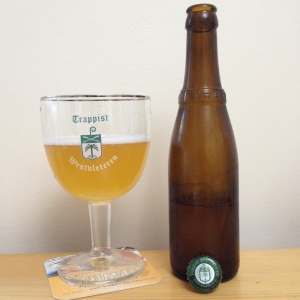
Is there Brettanomyces claussenii in this beer? I didn’t think there was but the last two I’ve had have definitely had a Brettanomyces character to them. Beer is yellow and light, nice moderate to high carbonation, yeasty, mildly bitter finish, not too dry but on the dry side. A solid beer but my least favorite from this famous brewery.

My favorite beer from Westvleteren. This is the perfect…dubbel I guess. Beer is medium in body, sweet in the nose and on the palate. It finishes with this mild grain bitterness but no aftertaste. The whole beer is round, warming without being boozy, brown sugar and complete. It is a perfect beer.
Bières de Chimay
By far the biggest brewery from a production stand-point. Chimay is everywhere in the world, including the United States. Listen, if you haven’t had Chimay stop reading this blog and go get some Chimay. My first Chimay was in a bar in Tempe, AZ. I was in lust with the waitress there and she mercilessly flirted with me. I ordered the bottle of Chimay and she brought it out quite literally covered in dust. She told me she had no idea how old it was and I was the first person to ever order one. She sat down and since we were the only ones there we drank it. It was the Red….They make three beers for sale to the public. My opinion, for what it’s worth, Blue > Red > White but I’d give the white a 7.5/10 and the blue an 8.5/10….I think they are all great beers but the blue being the best of the best in this group. There is another beer, Doreé…the “table” beer….not the best but the rarest so we have to try it. For good measure, we have the other ones as well.
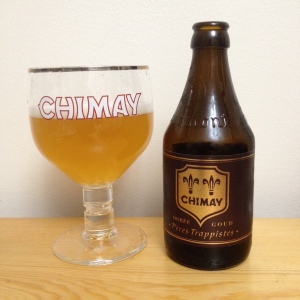
Beer is really light and highly drinkable. Mild citrus aroma. Beer is light on the palate and pretty nicely carbonated. The best way to describe it is “fresh” and “bright”…it is a solid beer and I’m glad these are becoming “easier” to find.
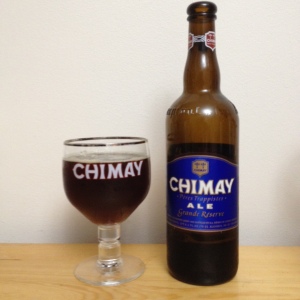
We decided to only do one of the regular Chimays because by the time we got to Chimay, we were feeling the fatigue of the day and drinking three 750ml bottles of beer we were familiar with did not sound like the best use of our already taxed metabolism. We did however choose the strongest of those three beers, the blue. This is basically another quad, a solid beer. Sweet, yeast aromatic, strong malt presence on the palate, a perfect finish. There is no doubt in my mind why Chimay dominates. This beer is available everywhere, just go buy one.
Brasserie d’Orval
Orval only makes two beers currently, Orval and Orval petite. Orval petite is a dry hopped, lower in alcohol, version of Orval and is only available at the monastery….so I’ve never had it (ONE DAY I WILL). That is seriously a bucket list beer for me. So, we are left with only one option, Orval. Orval is an amazing beer. It is bottle conditioned with Brettanomyces bruxellensis…the only Trappist beer that currently (intentionally) uses a Brettanomyces species, as far as I know. This was the first beer I ever had that used a Brettanomyces species, that was about 10 years ago now. It was eye opening for sure. This is one of my favorite beers now. Truly amazing. The other thing I love about Orval is the logo of the monastery. The logo is a fish (a trout to be more specific) with a gold ring in its mouth jumping out of the water. Seems pretty specific but there’s a story to go along with that image. Supposedly, Princess Matilda was traveling in the region where Orval is located currently in the year 1070. She stopped at a clear stream and ran her hand over the water at which point her wedding band fell in and sank. Her husband was recently deceased and she was beside herself with grief over losing her wedding ring. She knelt by the water and prayed for the ring to return to her. A trout swam to the top of the water with the ring in its mouth and returned it to her. She declared “This is a golden valley!” which in French is Orval (Or meaning gold and Val meaning valley). She donated all of that land to the church and the logo persists.
So, what do I think of Orval? Just a second, I have to get my Orval bar towel to answer this question…

What can I say about Orval that hasn’t been said before? This was a relatively young bottle of Orval so the funk was subdued but still present throughout. This beer I hold in such high regard…one of my all time favorite beers. It is truly amazing. The amber, mostly clear beer with an off white head, medium and large bubbles, decent retention but it doesn’t last forever…aroma of hay, leather, malt, pineapple…great body, nice yeast pops on the palate, not too dry finish, no aftertaste. The Brett comes through in the flavor really well, these younger bottles there is much more malt character compared to the funkiness of the Brett b…as close to the perfect beer I’ve ever found.
Brouwerij der Sint-Benedictusabdij de Achelse Kluis (Achel)
What is the correct pronunciation of “Achel”? I don’t know. In 1871, beer brewing started at this monastery but this location has a long history before that. It opened in 1648 but was destroyed during one of the French revolutions…eventually the monastery was rebuilt by monks from Westmalle and they opened a brewery there. This is a spin off of Westmalle then…trouble for this brewery (or Europe) wasn’t over unfortunately. During WWI, the German occupied the brewery and the monks fled. The German dismantled the brewery and used the scrap metal for their war effort. The brewery remained closed until the late 1990s…when they reopened and started brewing 5 different beers. For our livers’ sakes…I purchased two of their beers for our little tasting… onto the beers.

This was tried after Rochefort 10 and Westvleteren 12 since I consider this to be closest to those. It suffered in comparison a little bit but I do consider this beer to be a little bit of a Trappist sleeper. It is amazing. The aroma is sweet with a little alcohol tinge and molasses. The body is a little thinner than the others but it finishes nicely.

Achel blonde is a phenomenal beer. Light in color, pretty hazy, nice tall white head, lots of lacing, a lot of carbonation. Aroma is mildly citrus, mildly yeast, lots of nice aromatic malts. Solid body, mildly dry finish, not a hint of sweetness or alcohol, nice carbonation, no aftertaste clean finish. Wonderful beer.
Brouwerij de Koningshoeven (La Trappe)
If I’m being honest, this is my least favorite of the old seven Trappist breweries. I haven’t had anything from the new ones but these beers always strike me as having too much of that “bubble gum” ester some Belgian beers end up with. It is not a good flavor to me but I’m always willing to revisit a brewery or try a new beer, especially on recommendation. This is also a brewery where it is hard to establish when they became a “Trappist” brewery since they basically had to sue in the 1980s in order to keep using the label. As of today they are considered a Trappist brewery because things have changed a lot including having the profits now going to charity and the monks taking a more active role in the production of the beer.
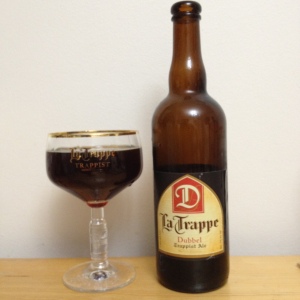
We only tackled one beer from this place to spare ourselves and livers. This was a good beer, much better than I remembered but the one word we all agreed on was “bananas” for this beer. This beer was a banana ester bomb, which has to be coming from the yeast. This being a dubbel and ignoring the strong banana ester, this is a fine beer, sweet with mild bitterness, not too boozy, sweet without any cloying to it. A nice beer overall, especially if you like bananas, which I do. There was a lot of banana though…
Stift Engelszell
This monastery was founded in 1293 but started producing beer in 2012, it is the only Trappist brewery currently in Austria..so that’s kind of cool. They make two beers Benno and Gregorious and we have them both. I know next to nothing about this place except that getting the glass was way more difficult than it should have been. As you might suspect…being in Austria for the past 700+ years, this place has had its share of drama..including the monks being drafted into the Nazi Wehrmacht and at least four being executed at the Dacha concentration camp for refusal to serve the Nazi government. After the war, a Trappist monastery in Bosnia was closed and most of the monks from that location repopulated this monastery. They are currently known for liquor and cheeses as well as their sustainable farming practices.
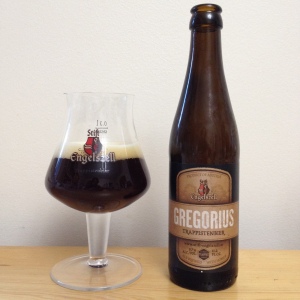
This beer? This was the pleasant surprise for the night…seriously. Gregorius is the real deal. Beer reminded me of the bigger beers from earlier in the night, notably the Westvleteren 12 and the Rochefort 10, in the same league in my opinion but not quite there. It was sweet and had notes of molasses and plums, nice finish, good beer all around.
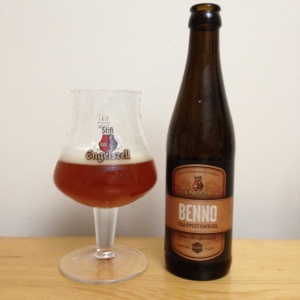
Unfortunately, Benno did not live up to its big brother Gregorius…this was one of my least favorite beers of the night. This beer is made with honey and it had a medicinal floral aroma to it that I couldn’t get past. The honey thinned the beer out and left an odd bitterness and the alcohol was not well hidden here. I finished mine but I doubt it would be a repeat for me…at least not for a while.
St. Joseph’s Abbey
U.S.A.! U.S.A.! U.S.A.! U.S.A.! (deep breath) U.S.A.! U.S.A.! U.S.A.! U.S.A.! FINALLY. We have our very own Trappist brewery…there are over 3000 breweries in the United States currently I guess we are running out of space and someone thought “put it in that monastery over there”. I’m pretty pleased that the United States can join in this ancient tradition. It makes sense, we are one of the half a dozen countries where beer is basically our culture, we should have a Trappist brewery. Currently the St. Jospeh’s Abbey (known for making jellies and jams…so I got some of those as well), only makes one beer. I had to trade for it because I don’t live in Massachusetts. I got a four pack and the glass…of course. The beer is a “patersbier” or “Father’s beer”…
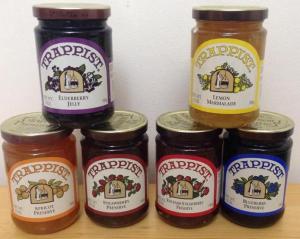
These were all good, I especially enjoyed the apricot and the strawberry. The lemon marmalade was incredibly strong….must love lemons to have that one.
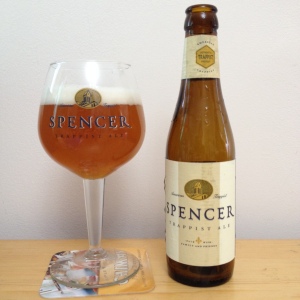
As you can see the beer is amber / orange with a white head, small medium bubbles, some lacing and a lot of carbonation. This was actually the first beer we drank that day and when the cap was removed the beer gushed everywhere. We opened three of these total and two out of the three were way way way overcarbonated, the third was still overcarbonated but not as badly as the first two. This was a nice beer…a little thin but great yeast profile and it could have been mistaken for a better established strong Belgian amber ale. Ryan and I discussed why exactly this beer bothered to be a Belgian style at all…if you think about it, this beer is made outside of Boston and there is nothing specific about being Trappist and brewing BELGIAN style beers. I realize this is likely a consequene of training and possibly marketing but some of these newer breweries setting up in countries with their own brewing traditions have an opportunity to expand the public perception of what is a Trapppist beer.
Brouwerij Abdij Maria Toevlucht (Trappistenbrouwerij de Kievit)
This last one is a little complicated. This brewery received permission to use the Trappist logo in 2013 and currently only produces one beer called Zundert Trappist. I know next to nothing about this particular brewery except that it is in the Netherlands and their website is in Dutch. Here is what little information I can piece together. It is a brand new facility (there is a brewery construction slideshow on their website)…that’s about all I have. It took some doing but I got the proper glassware for the one beer they produce…so onto the beer.
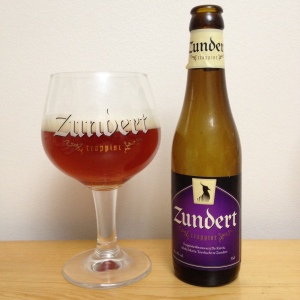
Another pleasant surprise from our tasting, this beer is most like a tripel, a little darker than normal if this is supposed to be a tripel but it hits the tripel button in my mind hard. Nice head, some lacing, strong yeast presence but there was definitely a maltiness to this beer, nice aromatic malt flavors overall. I really enjoyed this beer a lot. Clean finish, no aftertaste, nice bitterness on the end, very light overall. I’d have it again for sure.
Abbaye du Mont des Cats
And finally, #11…This brewery gets an “honorable mention” in my book for being a victim of history. Mont des Cats was a Trappist brewery until it was bombed out of existence in 1918 during one of those silly wars to prove who should be in charge of everything (spoiler alert…no one). They started brewing beer back in 1847, mostly for their personal consumption but improved and started making beer for sale to help with repairs they needed on the brewery and the monastery itself. After the destruction of the brewery in 1918, no beer was made at Abbaye du Mont des Cats again. In 2011, Mont des Cats started contract brewing beer at the Chimay brewery and selling at the monastery again. So you can see that this is not in line with the three rules outlined above and therefore not an authentic Trappist brewery. I decided to include them because they were once a Trappist brewery, currently sell beer, and the beer they sell is made for them by another Trappist brewery. I am unsure how serious their plans are to open a new facility at Abbaye du Mont des Cats in the near future, but they are the only exception I’ll allow in this list.
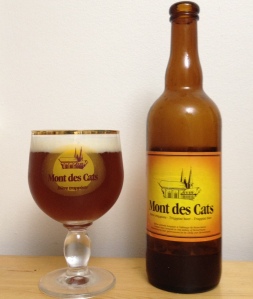
And finally, this guy. This beer was basically a strong amber ale, amber to almost brown in color, thin head of beige medium to small bubbles, some lacing moderate carbonation. The yeast aroma is really strong and nice. There is no bubble gum or banana ester just that solid sweet aromatic malt and mild yeast spiciness. This is a really nice beer and I recommend it to any Belgian beer fans.
This post is already long, but I wanted to point out that this list of breweries is a snap shot in time. There will likely be additional breweries added to this list of 10 (or 11) breweries above. There are definitely others on the bubbles, Ovila for one. Ovila is a brand of beer brewed by Sierra Nevada in Northern California in collaboration with Abbey of New Clairvaux in Vina, CA. Abbey of New Clairvaux is a Cistercian monastery and specifically a Trappist one but do not meet the requirement of producing the beer on the premises of the monastery…so they don’t count but could count in the near future. I honestly don’t know what their plans are moving forward with that brand but it is a clear example of an ALMOST Trappist beer brand and one day perhaps. They are one example of about a dozen nearly Trappist breweries currently in operation around the planet. I just hope that as more monasteries get into the game…the quality isn’t diluted. The breweries and monasteries above have set the bar pretty high for the Trappist tradition, let’s keep it that way.
“In de hemel is gee daarom drinken wij hee (In heaven there is no beer so we drink it here).” — Trappist Monk Proverb

The proverb goes as, “In the hemel is geen bier, daarom drinken wij het hier.” and it’s actually from a song from a band called ‘Katastroof’
Ah, thank you.
While I really like Trappist beer, I’m not particularly partial too it, but reading this post really made me crave some of these… Let’s hope for a business trip to Brussels in the future… It’s been a while 🙂
La Trappe Bockbier en Isi’dor are imho the best beers from that brewery. My favorite by far is Achel. Kudos for getting all the proper glassware. Surprised you got your hands on a Zundert. The Dutch like their beer a little sweeter than the Belgians, its not unusual that people pour the trappist on a little syrup concentrate.
Achel definitely doesn’t get enough respect. As far as Zundert…that took some doing…a lot of doing. But the last glass and beer I obtained (two days before this tasting) was the one from Boston…oddly difficult to get that.
It was a lot of fun. Probably never get to that again.
Only now discovered your blog. (Sorry for the late response.) Curious where you found the Stift Engelszell glass; I’d really love to get my hands on one!
Interesting reading the definition of a trappist beer. Really leaves the door open to all beer types.